Dirty job: Entry. Refill HP Color Inkjet Print Cartridges
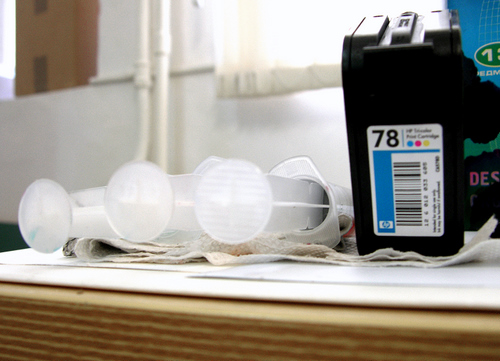
With this short review, I would like to begin a series of stories about the “dirty” part of my work, namely, about the following points:
- Refill HP Color Inkjet Print Cartridges
- HP toner cartridge refill
- Wersacamm SP-540V plotter overview
- Overview plotter BigPrinter PJ 3216
Lyrics
As we were recently told by the distinguished Boomburum , there is such a wonderful thing in the world as a CISS . The thing is certainly useful and necessary not only at home, but also in the work of a small advertising studio, by the standards of Moscow and the region. In my case, CISS is used in three cases:
- Two regular A4 printers (Epson Stylus C87 and Stylus Photo RX600)
- One printer for printing with sublimation ink for the subsequent thermal transfer of the image on various surfaces of format A3 (Epson Stylus Photo 1270)
- Two wide format printers, also called plotters (Wersacamm SP-540V and BigPrinter PJ 3216)
But this technology has its drawbacks. One of them: it is not possible to install CISS on printers from HP, due to the design features of their cartridges, namely, the ink tank is combined in one container with the so-called “head”. With a strong desire to find some poor solutions of course possible, but they are strictly not recommended by experts.
As a result, users of HP printers have a genuine problem - expensive original (from the manufacturer) cartridges plus permanent envy of the owners of printers from Epson, who, by the way, besides their relatively cheap original cartridges, have always been extremely cheap and have their Chinese counterparts. But since the original moment in our country is also the desire to save on "unnecessary and unjustified" costs, HP printers almost immediately appeared on the shelves of stores along with sets for their refueling.
')
These kits were from different manufacturers (if you can call them that way :), with different design solutions and, as far as I know, they brought a lot of problems not only to ordinary users, but even to professionals in the field of maintenance and repair of office equipment.
Today, after many years from the first refilling of an HP inkjet printer cartridge, I want to present to you the most simple and convenient scheme for refilling them, verified by years. I can say in advance - the whole process of directly filling up takes less time than searching for tools in the corners for this activity :)
Training
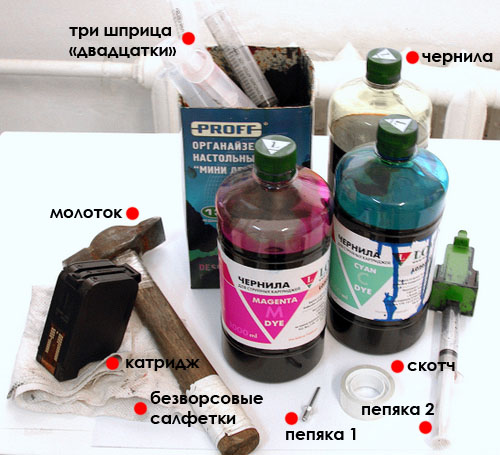
For refueling we need:
- Three syringes "twenty" (sold in any pharmacy)
- Inks of 1 l (the brand of ink can be seen in the photos, and they completely suit me for quite some time, but in general, you can use any that will advise you in the nearest computer store)
- Cartridge (you may need several more copies to install it, more on that below)
- Hammer
- Lint-free disposable wipes (not sold everywhere, so ordinary ones will do)
- Scotch
- Peppyack 1 (rivet)
- Pepyak 2 (a device for refilling cartridges from a set of 19 ... inaudible years
It is better to perform all operations before bedding any waterproof material. In my case it is a backing from a self-adhesive film.
Step 1: Holes
If the cartridge is already refilled earlier, then this step can be omitted. Otherwise, we need to prepare openings for the introduction of the syringe. This is done simply, “Pepyaka 1” is taken (in my case it is a rivet, but any sufficiently strong thing similar to its diameter can be used. We put the cartridge on the edge of the table and in turn, carefully, drive all three technological plugs inside the cartridge ( sorry for the photo "out of focus"):

Professional comment:
In fact, from a technical point of view, it would be more accurate to pull out the plugs and insert them back after refueling (or burn the thin holes next to them and do not touch the plugs at all), since they have a complicated air labyrinth to maintain the “correct” pressure in cartridge
But my practice shows that the tape, which as a rule is impossible to glue absolutely tightly, perfectly fulfills the role of these complex mazes. If you are not satisfied with such a decision, I leave this process at your discretion. However, do not forget that you still need to cover the holes with tape as tightly as possible, otherwise you risk filling your printer with all the contents of the cartridge.
As a result, we get three neat holes:
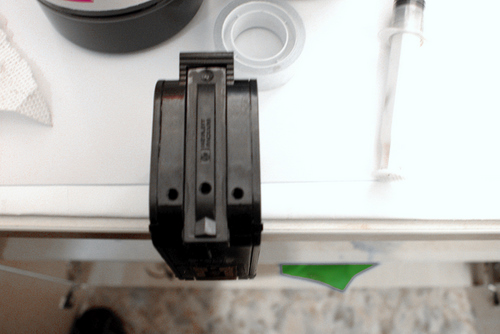
Step 2: Refueling
Next, fill all three syringes with ink. Two things need to be taken into account: firstly, different cartridges can be of different capacities, secondly, at the moment when the printer starts to signal the end of the ink, only one of the colors actually ends, the rest can be filled very noticeably. By the weight of the cartridge gradually begin to navigate in this matter. As a result, I eventually decided to collect ink in syringes for about 75% of the initial volume of the cartridge:
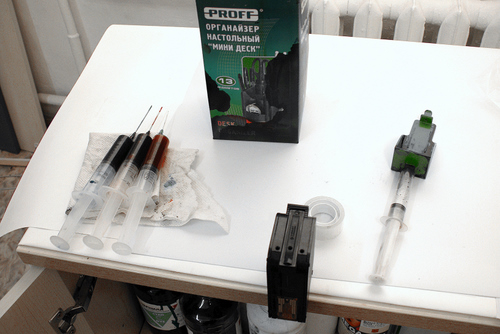
After we have prepared everything directly for the process itself, I would advise you to stock up with several napkins for quickly wiping your hands and excess ink, not always the process goes smoothly. Its essence is as follows:
The cartridge for each color has its own compartment, it contains a certain porous material, extremely similar to the good old foam. In order for our refueling to be as painless as possible, the needle of the syringe needs to be inserted so that the needle tip is almost at the bottom of the reservoir and as close as possible to the place where the heads are. In this way, we will avoid possible “air bubbles” in the cartridge, which is rather difficult to get rid of.
So, we put the cartridge on napkins laid in several layers and slowly inject ink into the tanks, but before that we do not forget to check what color the ink is in which compartments. In my particular case, the colors are the opposite in relation to the designation of them on the label (the label can be seen in the title picture).
Step 3: Postpartum Treatments
If everything went smoothly, then all the ink will get to its intended purpose and only a small pool will remain under the cartridge. If the ink flows like a river from the nozzles or goes from the technological holes, then there is a reason to either think about an excess amount of ink and supplying it to the tanks too quickly, or about buying a new cartridge, since this is probably not very suitable for printing. But for the first time everything happens always smoothly. After we made sure that everything went exactly as we expected, I advise several times to “get wet” the “head” of the cartridge from excess ink:

In the event that you do not have “Pyaq 2”, then do not worry, you can refill without it. It represents the structure of the frame in which the cartridge is attached, resting his "head" on the gum, and a syringe that is connected to the hole in the above-mentioned gum. It is used to remove excess air from the bottom of the ink tanks:
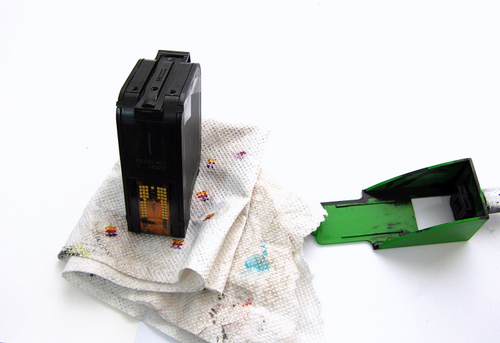
But if after “getting wet” you have traces like in the following photo, then this step can be omitted:
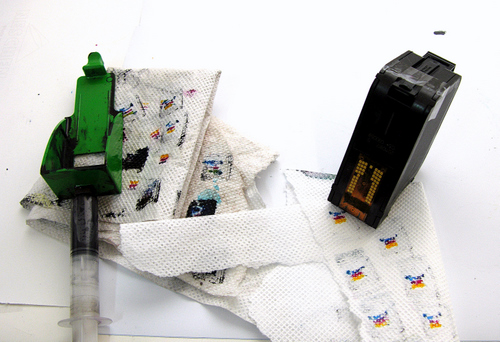
If not all the colors appear on the napkin, you can either try to “get to the glands” again, that is, supply ink to the very bottom of the tanks, or just let the cartridge stand (preferably with open top holes and close to the “napkin”). If you go the second way, then check whether the ink began to protrude from the nozzles should be at least 10 minutes, otherwise you risk seeing all the fruits of the work done leaked onto the napkins.
After we on the napkin still remain clear traces of all three colors, technological holes on top of the cartridge are sealed with tape, prudently glued to one side of the cartridge.
Hint: After you insert the cartridge back into the printer, it may be determined by the printer as already used and as a result the printer will refuse to work with it. But in general, this is not terrible, since the printer usually remembers only the last two healthy (that is, it is possible that even empty, but working) cartridges. This is where our old used cartridges come in handy.
Announcement
Wersacamm SP-540V:
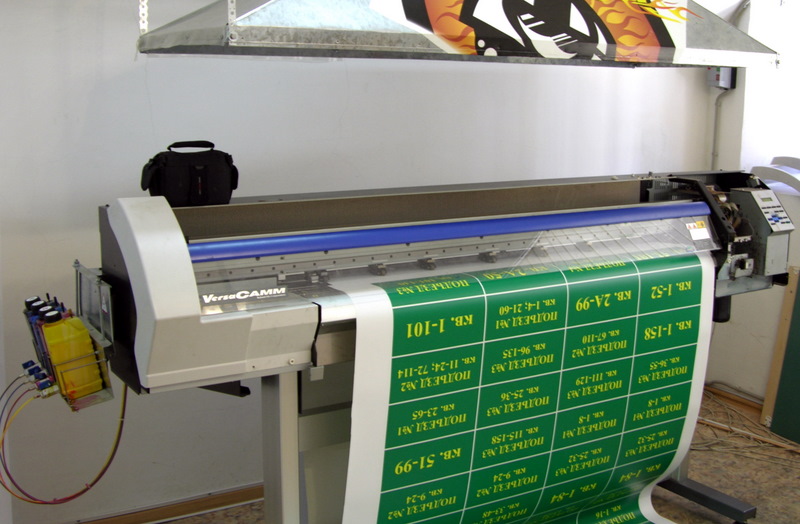
BigPrinter PJ 3216:
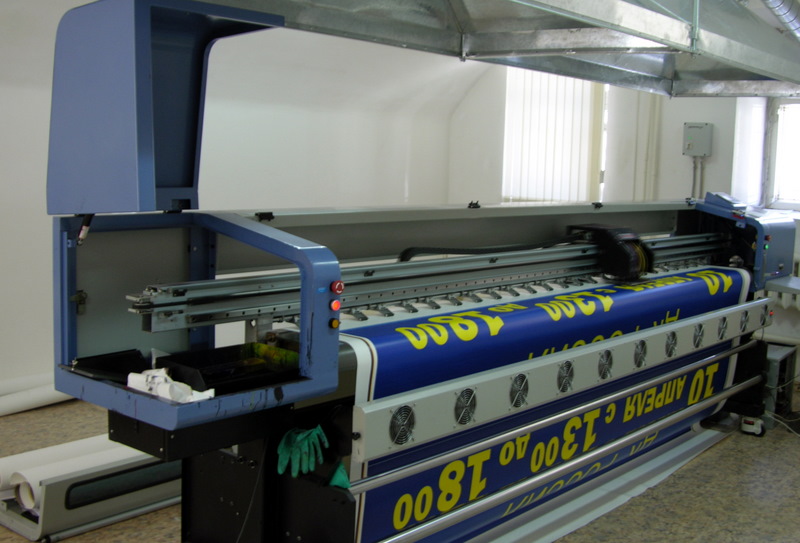
PS: Sorry for the photos are not of the highest quality, in the middle of the shooting I remembered that I did not set the white balance and I had to bring to mind already in CS4.
PPS: The topic at first glance is utterly beaten up and should be known to all interested parties, but on closer examination it turns out that the original cartridges from HP are still in demand on the shelves, and no one is immune from employment in an organization where still using printers from HP. Also, not so long ago, the prices of these cartridges have increased quite significantly.
Source: https://habr.com/ru/post/88620/
All Articles